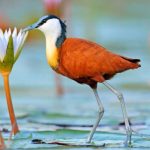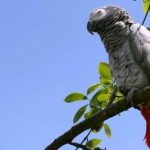Discovering the Majestic Albatross: A Comprehensive Guide to their Habitat and Behaviors
Albatross Facts
- Colonial Nesting
Albatross Physical Characteristics
- Color
-
- Brown
- Grey
- Yellow
- Red
- Black
- White
- Skin Type
- Feathers
- Top Speed
- 50 mph
- Lifespan
- Up to 50 years
- Weight
- Up to 22lbs (10kg)
- Length
- Up to 4.4ft (1.2m)
- Age of Sexual Maturity
- 5 to 10 years
The albatross glides elegantly over the waves, its wings stiff and strong against the brisk breezes.
The image of this well-known seabird with its expansive wingspan soaring above the ocean has captured human creativity and fueled legends and folklore for centuries. This bird is a remarkable survivor, equipped with distinctive adaptations to cope with the challenges of prolonged sea life. Unfortunately, competition with humans over food has led to a sharp decline in their population.
5 Amazing Albatross Facts!
- A longstanding sailing legend suggests that the albatross bears the soul of a sailor who died at sea, representing either a positive or negative sign depending on who interprets it. Despite this grave belief, it did not prevent people from hunting or eating these birds. This concept plays a crucial role in Samuel Taylor Coleridge’s 1798 poem, “The Rime of the Ancient Mariner.” After the protagonist kills an albatross, his ship encounters a string of calamities, leading his fellow sailors to force him to wear the dead bird around his neck as punishment. This has led to the phrase “albatross around the neck.”
- The term albatross is derived from an Arabic word, al-qadus or al-gaṭṭas, which translates to “the diver.” The Portuguese adapted it to alcatraz (the name of a well-known American prison), which was later incorporated into English.
- Besides the nesting period, the albatross is nearly always in motion, with an individual often covering thousands of miles each year.
- An alternative name for the albatross is the goony bird, referencing the awkward manner in which it lands, often tumbling forward.
- Globally, birdwatching is a favored hobby. The northern royal albatross colonies in New Zealand attract approximately 40,000 visitors each year.
Discover more fascinating details about the albatross.
Scientific Classification

The scientific designation for albatrosses comes from Greek mythology
©Marti Bug Catcher/Shutterstock.com
The scientific designation of the albatross is Diomedeidae, named after the legendary Greek hero Diomedes, who is said to have fought in the Trojan War. According to one myth, albatrosses sang at his passing. Given the contentious nature of albatross classification, estimates of species range from 13 to 24, depending on the classification method. For instance, there’s ongoing debate among taxonomists over whether the royal albatross constitutes a single species or consists of two distinct northern and southern species. The albatross belongs to the Procellariiformes family alongside petrels, shearwaters, and other seabirds, with the last common ancestor of this lineage existing over 30 million years ago.
Physical Appearance
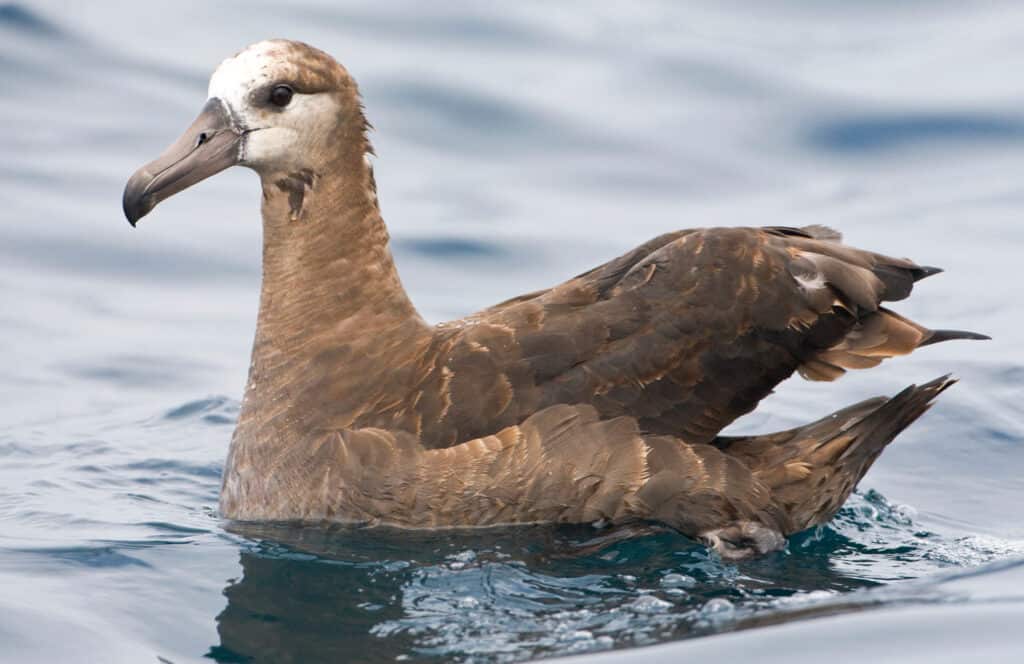
Albatrosses are distinguished by their remarkable wingspans
©Agami Photo Agency/Shutterstock.com
The albatross is a robust, large-bodied bird, typically exhibiting a mix of white, black, or gray colors (certain species, like the southern royal albatross, are almost entirely white). It possesses a long, hooked beak that is orange or yellow in color, with various horned plates. It also features tubes along its bill’s side to help measure airspeed during flight.
What sets the albatross apart is its extraordinary wingspan. The great albatross (especially the wandering albatross) is recognized as the largest living bird group on the planet, with wings extending up to 11 feet across. It can weigh as much as 22 pounds, comparable to a swan. Even smaller species have wingspans around 6.5 feet, longer than most birds.
The albatross showcases stiff, arched wings since it seldom flaps them. Instead, it glides on ocean breezes for extended periods with minimal body movement, a necessary adaptation given its considerable weight. However, this also limits its capacity to fly in low wind conditions. On the plus side, the albatross expends very little energy while in flight.
Evolutionary History
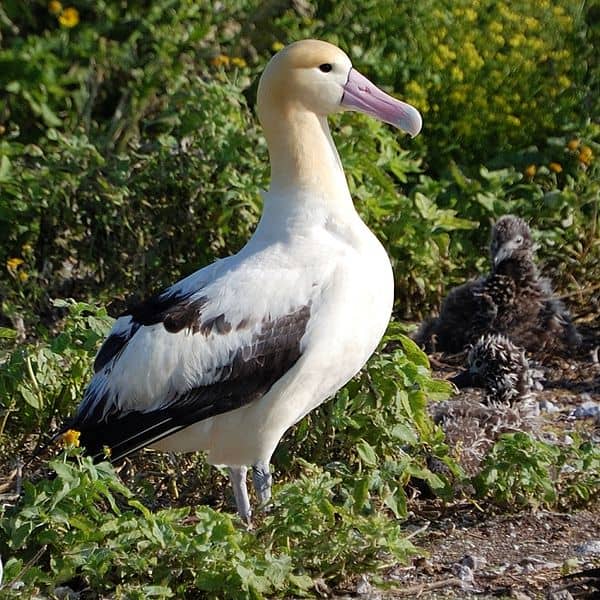
The oldest known fossils of albatrosses date back to the Oligocene epoch
©Jlfutari at English Wikipedia, CC BY-SA 3.0, via Wikimedia Commons – Original / License
The earliest fossil records of albatrosses, specifically Tydea septentrionalis, date back to the early Oligocene and were found in Belgium. Additional fossils from the Eocene and Oligocene periods have been discovered across Central Asia, New Zealand, and South Carolina.
Researchers theorize that the great albatrosses and their North Pacific counterparts diverged around 15 million years ago, while the mollymawks and sooty albatrosses separated about 10 million years ago.
Species Variety
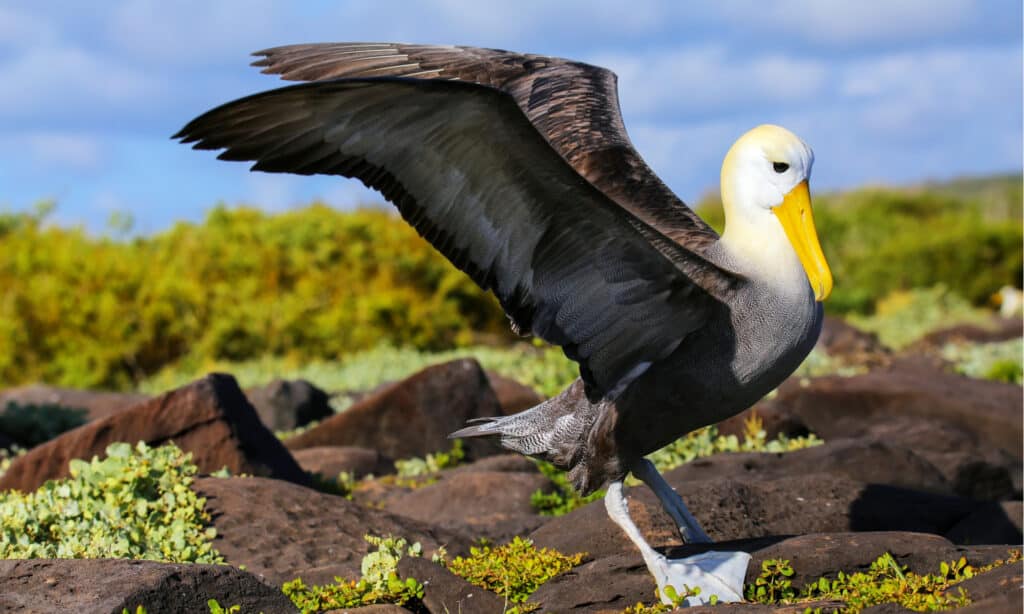
There are 22 species of albatross worldwide
©Don Mammoser/Shutterstock.com
Currently, 22 species of albatross exist, including:
The great albatrosses (Diomedea)
- Wandering albatross (D. exulans)
- Antipodean albatross (D. (exulans) antipodensis)
- Amsterdam albatross (D. (exulans) amsterdamensis)
- Tristan albatross (D. (exulans) dabbenena)
- Northern royal albatross (D. (epomophora) sanfordi)
- Southern royal albatross (D. epomophora)
Behavioral Patterns
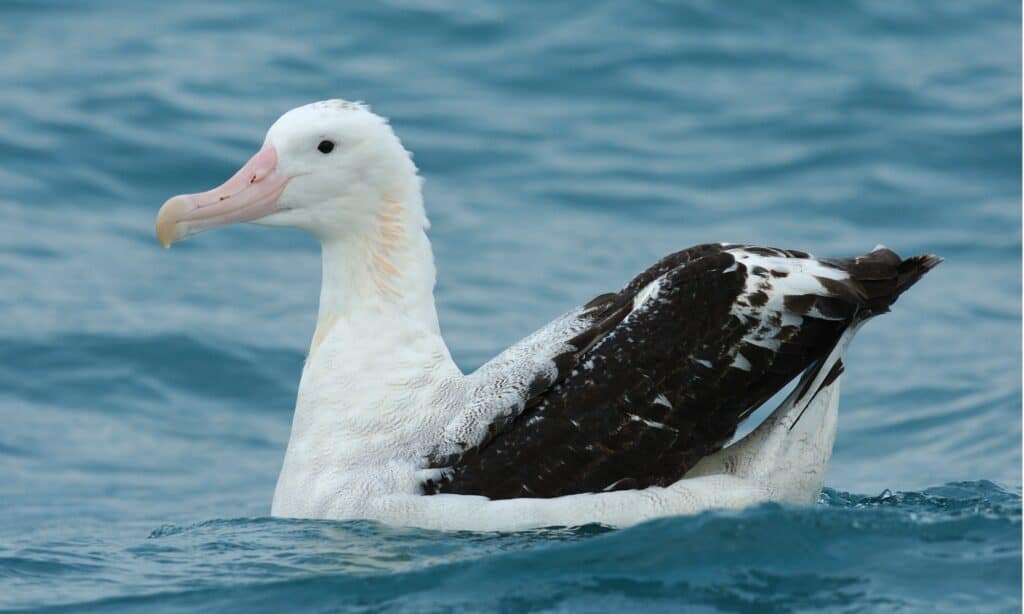
Albatrosses have the unique ability to drink seawater due to their specialized salt-excreting organ
©iStock.com/hlansdown
The albatross is remarkably adapted for extensive periods at sea. It possesses the ability to ascend in the air with minimal energy expenditure and can drift effortlessly above the water. While more exposed at sea, the albatross does require occasional landings to feed and hydrate. It features a unique organ that eliminates the surplus salt consumed while drinking seawater. Although it thrives at sea, the albatross often pauses on remote islands to rest. During the breeding season, they return to shore and gather in sizable colonies that vary in density among species. They seem naturally drawn back to their birthplace’s colony.
Natural Habitat
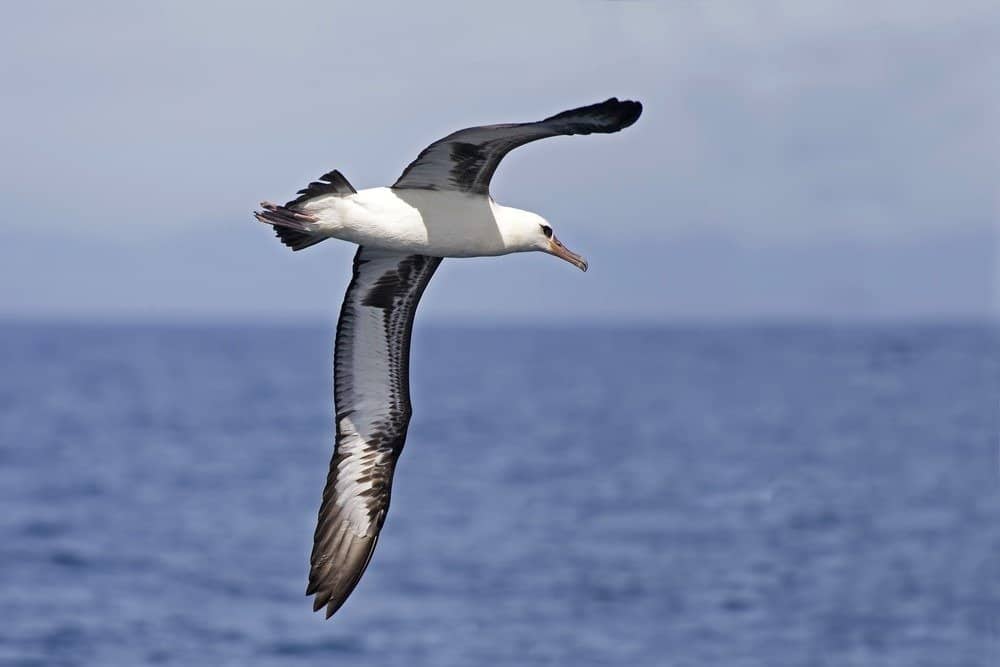
Albatrosses can traverse vast ocean expanses, propelled by strong winds
©Harold Stiver/Shutterstock.com
The albatross primarily inhabits the Southern Hemisphere around Antarctica, South America, South Africa, and Australia. Historically, its range extended significantly into the Northern Hemisphere, but now only a select few species are found in the Northern Pacific region, spanning areas from Alaska to California, Hawaii, and Japan. With its capacity to consume seafood and drink saltwater, the albatross faces few obstacles in traversing the vast oceans. Its only essential requirement is a robust wind to thrive; it struggles in areas where the wind is lacking.
Nutritional Habits
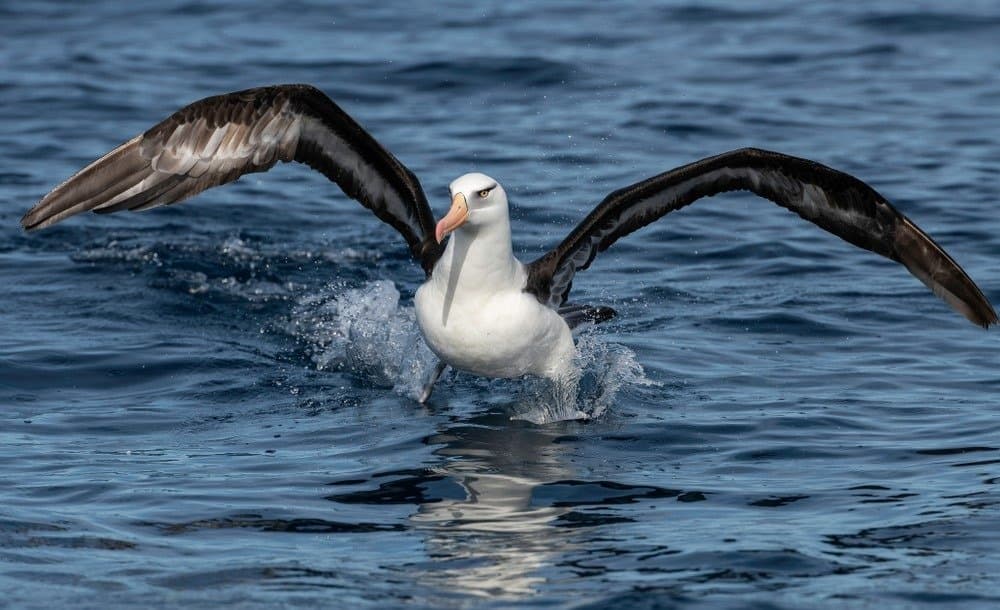
The albatross’s diet varies by species
©wildestanimal/Shutterstock.com
The albatross diet predominantly consists of squid, krill, and schools of fish, with zooplankton (tiny marine organisms) being a less common food source. This seabird is opportunistic and will readily follow vessels to scavenge waste or consume dead carcasses that float on the water’s surface. The specific makeup of their diet differs among species. In contrast to other dominant seabirds like penguins, many albatross species (such as the wandering albatross) can only dive a few feet below the surface, making it challenging to secure enough sustenance. Should they spot prey from the air, some species can plunge swiftly into the water to catch it.
Predation and Hazards
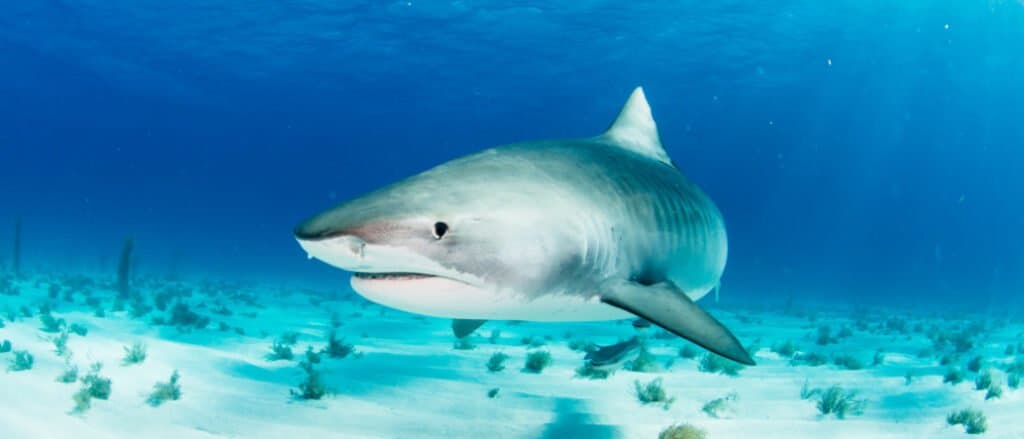
Tiger
sharks occasionally target juvenile albatrosses
©Yoshinori/Shutterstock.com
This seabird, spending extensive time above the ocean (where larger carnivores are absent), has few natural predators. However, young albatrosses sometimes fall prey to tiger sharks, while introduced species like cats and rats may eat their eggs.
The primary looming danger is humans. In the Arctic, some indigenous peoples may have historically hunted albatrosses as a significant food source. Their feathers also served as valuable materials in crafting luxury hats. Yet, the most critical threat to their survival stems from dwindling food supplies, driven by overfishing. The albatross constantly competes with humans for limited resources in the ocean. Moreover, marine pollution poses a threat as it gradually accumulates in the environment, adversely affecting the food chain. This persistent contamination can lead to developmental issues, reproductive difficulties, and eventual mortality.
Reproduction, Offspring, and Lifespan
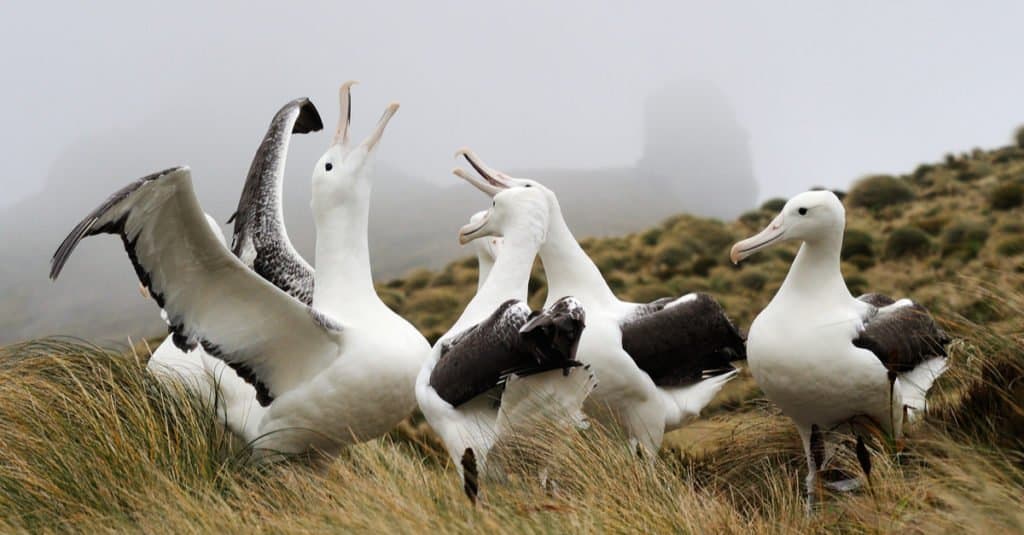
Albatrosses form lifelong pair bonds, with both parents nurturing the chick
©AndreAnita/Shutterstock.com
After spending a long time at sea, the albatross travels to isolated islands and coasts to mate. They are selective in their partner choices, as numerous species are monogamous for life, making it vital to select wisely. Their courtship involves a complex display of songs and dances to signal their readiness to mate, featuring preening, gazing, bill interactions, vocalizations, and pointing. This ritual is perfected over years by younger birds through experience, ultimately leading to the selection of a lifelong mate. This intricate process is crucial for their survival.
Once a pair bonds, they typically stay together for life. Even if they encounter difficulties in breeding, they rarely separate. The strong bond fosters significant trust, allowing them to jointly incubate eggs, raise their young, and build large nests using grasses, soil, shrubs, and even feathers. They often choose elevated locations with multiple access points.
After mating, they lay a single egg each breeding season, generally skipping a year before reproducing again. The new chick hatches after a few months, underdeveloped and entirely reliant on its parents for sustenance. During the initial stage of its life, the parents take turns between protecting the chick and gathering food. They nourish the chick with a mix of krill, fish, squid, and a nutrient-rich substance from their stomachs derived from previously consumed prey.
Due to food scarcity, growth occurs slowly and is quite arduous. Several weeks will pass before the chick can fend for itself. It then takes an additional three to 10 months to fully fledge (gain flying capability) and subsequently begin its independent quest for food. The young albatross spends the subsequent five to 10 years at sea, returning to breed only upon reaching maturity. The lifespan of an albatross can extend up to 50 years, with a few particularly long-lived individuals documented. Many albatross chicks don’t survive their juvenile phase. Learn about the oldest living animals on earth here.
Current Population Status
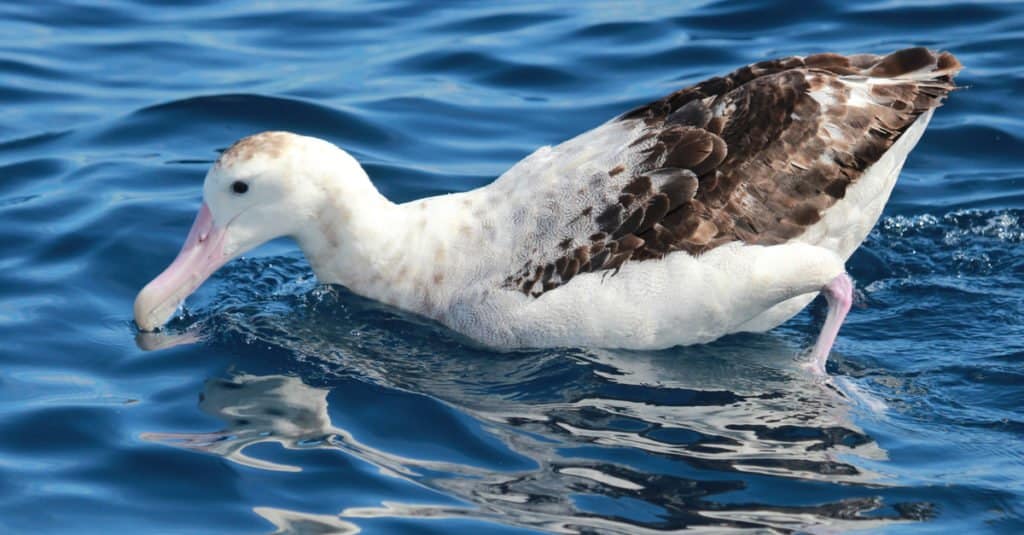
Numerous albatross species are threatened in various ways
©Imogen Warren/Shutterstock.com
Years of human carelessness have significantly impacted the albatross population. Nearly every species recorded on the IUCN Red List faces some level of threat. The Laysan albatross, with a natural distribution throughout the Pacific, is classified as near-threatened, with around 1.6 million adults remaining in the wild. Conversely, critically endangered species like the waved albatross and the Tristan albatross have mere thousands left. Most species are in between these two extremes, with anywhere from 10,000 to 100,000 mature individuals remaining. For example, the massive wandering albatross is currently considered vulnerable, with an estimated 20,000 left.
Conservationists ascertain that improved management of fishery resources will be essential for restoring albatross populations. Habitat recovery efforts and banning harmful pollutants will likewise contribute positively. Actions taken at the national level alone are insufficient; worldwide collaboration is crucial due to the extensive range of the albatross (and since changes in one area can impact others).
Complete Species List
The great albatrosses (Diomedea)
- Wandering albatross (D. exulans)
- Antipodean albatross (D. (exulans) antipodensis)
- Amsterdam albatross (D. (exulans) amsterdamensis)
- Tristan albatross (D. (exulans) dabbenena)
- Northern royal albatross (D. (epomophora) sanfordi)
- Southern royal albatross (D. epomophora)
The North Pacific albatrosses (Phoebastria)
- Waved albatross (P. irrorata)
- Short-tailed albatross (P. albatrus)
- Black-footed albatross (P. nigripes)
- Laysan albatross (P. immutabilis)
The Mollymawks (Thalassarche)
- Black-browed albatross (T. melanophris)
- Campbell albatross (T. (melanophris) impavida)
- Shy albatross (T. cauta)
- White-capped albatross (T. (cauta) steadi)
- Chatham albatross (T. (cauta) eremita)
- Salvin’s albatross (T. (cauta) salvini)
- Grey-headed albatross (T. chrysostoma)
- Atlantic yellow-nosed albatross (T. chlororhynchos)
- Indian yellow-nosed albatross (T. (chlororhynchos) carteri)
- Buller’s albatross (T. bulleri)
The Sooty albatrosses (Phoebetria)
- Sooty albatross (P. fusca)
- Light-mantled albatross (P. palpebrata)
What is an albatross?
The albatross is a family of large seabirds that spend the majority of their lives far from land. It distinguishes itself from similar seabirds, such as petrels and shearwaters, by its remarkable size, skeletal structure, and the placement of the tubes on its bill (located on the sides rather than on top), which assist in measuring airspeed.
Do albatrosses sleep while flying?
It has been long speculated by scientists that these birds must doze while in flight given their lengthy time spent out at sea. The great frigatebird, for example, appears to sleep intermittently while soaring over the ocean. However, a more plausible theory suggests that the albatross rests on the water at night. Tracking studies indicate that they float on the ocean surface for several hours, seemingly not engaging in foraging.
Where does an albatross lay its eggs?
During the breeding period, the albatross returns to land to construct a nest on elevated terrain near the shore.
How big is an albatross?
The wingspan of an albatross can range from 6.5 to 11 feet, depending on the specific species.
What’s the difference between an albatross and a seagull?
While they may appear alike at first glance, gulls and albatrosses belong to completely different taxonomic families. Gulls are typically ground-dwelling birds, whereas albatrosses venture far over the sea. Additionally, gulls are generally smaller and exhibit a more developed social structure with noteworthy tool-utilizing tendencies. Their colonies are densely packed and full of vocalizations. In contrast, the albatross focuses more on familial matters than on the broader colony dynamics.
Are Albatrosses herbivores, carnivores, or omnivores?
Albatrosses fall into the carnivore category, which means they primarily consume other animals.
What Kingdom do Albatrosses belong to?
Albatrosses are part of the Kingdom Animalia.
What phylum do Albatrosses belong to?
Albatrosses belong to the phylum Chordata.
What class do Albatrosses belong to?
Albatrosses are classified within the class Aves.
What family do Albatrosses belong to?
Albatrosses are part of the family Diomedeidae.
What order do Albatrosses belong to?
Albatrosses are categorized under the order Procellariiformes.
What type of covering do Albatross have?
Albatrosses are equipped with feathers.
Where do Albatrosses live?
Albatrosses are found in the Southern Hemisphere and the North Pacific region.
In what type of habitat do Albatrosses live?
Albatrosses typically inhabit open seas and oceans.
What are some predators of Albatrosses?
Common predators of Albatrosses include humans, sharks, cats, and rats.
What is the scientific name for the Albatross?
The scientific classification for the Albatross is Diomedeidae.
What is the lifespan of an Albatross?
Albatrosses can live to be as old as 50 years.
What is a baby Albatross called?
A young Albatross is known as a chick.
What is the biggest threat to the Albatross?
The most significant threat to Albatrosses is the depletion of their prey due to overfishing.
What is another name for the Albatross?
Albatrosses are also referred to as mollymawks or gooney birds.
How many Albatrosses remain in the world?
The population of Albatrosses varies by species.
How many offspring do Albatrosses typically have?
On average, an Albatross has one chick.
What’s an intriguing fact about Albatrosses?
Albatrosses are known to possess the largest wingspan of any bird globally!
How fast can an Albatross fly?
An Albatross can reach speeds of up to 50 miles per hour.

